When is the best time to go fishing? If you are a regular angler you’ve probably been asked this a thousand times. Or maybe you’ve asked this of others. So what is the answer? Is there such a thing?
Some anglers believe the answer to this question is just a case of buying an Angler’s Almanac or checking the Maori tide charts and going fishing at the best predicted times. But what if it has rained for two weeks solid, or it’s blowing a gale, or there are 40 boats sitting on your secret spot? Can you seriously expect to catch fish then just because a chart tells you that you can?
The answer is no; it’s not that easy. Anglers should not expect cut-and-dried predictability when they go fishing. That’s not to say fishing results are just random, and that tides, times and moons don’t matter – they do. It is just that other factors are at play. To maximise your chance of fishing success you need to weigh up a whole range of information, and then be able to adapt your plans if all doesn’t go to plan.
Let’s take a look at some of the key factors at play to maximise, rather than guarantee, your chances of fishing success.
Very often I see or hear casual anglers going fishing on the spur of the moment, or when they can fit a trip in between weekend chores. In today’s busy society, finding the time to go fishing can be challenging at times – but this is all the more reason to make the most of it when you do go.
With a bit of planning, casual and seasoned anglers can go well-armed with information and not simply turn up and hope for the best. Whether you a planning a two-hour session or a week long fishing trip, you should go prepared by looking at tide charts, moon phases, weather forecasts and fishing reports, and have a specific plan to target one or more species. Let’s have a look at each of these factors in more detail.
Having a basic fishing plan should start with finding out the best seasons to target specific fish species in your local or chosen area. In Southeast Queensland, for example, there’s not much point in targeting tailor off the beach in summer when you’d be much better off chasing summer whiting. Likewise, if you want to catch a mangrove jack, there is little point targeting them on a cool winter day when you would be better off targeting schooling bream or luderick in your local estuary.
Apart from reading magazines such as this, there is also a wealth of books that will help you understand your local fishing seasons and the best places to target fish locally. Look for those that have some localised maps and information such as the River to Reef series (by Bill Johnston); the Gregory’s Fishing Guide; Australian Fishing Network area guides and some of the older books such as Fish Australia: An Essential Fishing Companion as well as Fishing Monthly Magazines’ South East Queensland and Queensland Fishing Annuals from the late 1990s to early 2000s if you can get your hands on them from a library or ebay. Of course there is also a wealth of information on the internet in websites, Facebook pages and forums.
All anglers should also keep a fishing diary to look for regular patterns in your own fishing. If you record a range of information on species caught, time, moon, tide, weather, baits and lures, after a while a pattern will emerge. As I’ve spoken about in this magazine before, the best way to do this is either in an electronic fishing diary such as an Excel spreadsheet or in a commercially available product such as Ken Fox’s Fishing Log. The Fishing Log can be downloaded in a format that burns onto a CD. It lets you record all the useful fishing information, plus you get the benefits of seeing your GPS spots displayed on point-and-click maps. It also has animated graphics for how to tie knots, tide information and more. Ken can be contacted on (08) 8298 4527.
Once you know the various seasons to target your favourite fish, the next thing to consider is the tides. Which are the best tides for fishing? There is no definitive answer, but there are some rules of thumb you can apply for particular species.
For example, species such as flathead and barramundi are ambush predators, and use the falling tides or lack of water to sit and wait for baitfish to retreat from shallow water. The predators position themselves at the edge of sandbank drop-offs, weed-beds, drains, gutters, small creeks and bankside snags for baitfish to return to deeper water as the tide drops. Likewise, they will wait for the first hour of the tide for the survivors to head back up to the shallows before spreading out.
It’s a different story for foraging predators. Rising tides give foraging fish such as whiting and bream access to yabby banks and oyster racks in estuaries, which might otherwise be exposed on low tide. The edges of mangroves are also a top spot for bream on high tide, as are tiny creek offshoots that are generally accessible only on the largest of spring tides.
These are only general rules though. It’s still possible to catch flathead on a rising tide or whiting on a falling tide. In fact, on some exposed beaches like Fraser Island I find the hour just before and after low tide is the best time to chase whiting off the beach. However, you need to find the right gutters that give fish access to the worms and pipis right at the edge of the shore break.
Another rule of thumb with the tides applies to active northern predators like barramundi, mangrove jacks and trevally. These fish are expert feeders when the tide is running and pushing the baitfish towards them. This running water reduces the reaction time of fish, which is useful for anglers. It means these predators have limited time to decide whether the item coming towards them is a legitimate meal or a piece of plastic or bait with a hook in it.
When the tide changes and slows, their reaction time increases so their feeding tends to slow at the top of the tide. That’s why the saying ‘no run, no fun’ is so often true when fishing up north.
That said, too much run in a location can make life difficult for the predators. They don’t want to expend more energy holding their position than they expect to get in return from their prey. In these situations the predators will take up position in eddies, backwaters, deep holes and any other place where the current is being disrupted, such as around bridge pylons or sunken trees. These are the areas to target during the fast running middle stages of the tides.
It’s a good idea to change your style of fishing according to the stage and pace of the tide. For example, fishing lightly weighted soft plastics may be a good option in bays, reefs and estuary channels within about two hours before and after the change of tide, but outside of that time a better option can be to drift with bait or troll lures. This includes trolling soft plastics in shallow water during the middle stages of the tide.
Right around the world there are coastal cultures that predict fishing success or failure according to moon and sun cycles. Likewise in Australia we have a commonly used fishing predictor, the Angler’s Almanac. So what lies behind these forecasts or predictions, and do they work?
Before I give my own opinion on that question, let’s have a look at how the moon and sun affect the tides.
Tides are caused by the moon’s gravity pulling on the water in the oceans. This creates bulges in the ocean on both sides of the Earth. The bulge on the side closest to the moon is caused by the moon directly pulling on the water. The bulge on the side of the Earth farthest from the moon is caused by the moon ‘pulling the Earth away’ from the water on that side. Therefore, if you are on the coast and the moon is directly overhead, you should experience a high tide. If the moon is directly overhead on the opposite side of the planet, you should also experience a high tide. This is why we have two high and two low tides during a 24-hour period.
While the moon has the most influence on our tides, the sun also has an influence. Solar tides are about half as strong as lunar tides, because the moon is much closer to the Earth. When the sun, moon and Earth are in alignment (at full or new moon), the solar tides add to the lunar tide. This creates bigger high tides (king tides) and lower low tides (spring tides). Conversely, the smallest variations in the tide between high and low are called neap tides, and these occur around the first and last quarters of the moon.
The theory of the Angler’s Almanac and some indigenous coastal cultures around the world is that fish feeding and spawning activity is influenced by sun and moon activity in addition to the tides. The peak time to fish, according to these theories, is when the moon is above the angler’s head or when it is directly overhead on the opposite side of the earth. When the moon is halfway between these points, the theory is there is a minor period of activity.
So do these theories work? Having worked with economic statistics for many years, I’m a little sceptical on hard and fast theories without seeing data as evidence. For that reason I have kept a detailed fishing diary for 20 years to see whether the theories measure up. I have plugged my results into spreadsheets and produced graphs to look at possible causes and effects on my fishing success or failure.
My results echo those from experienced fishing guides I’ve used over the years. Moons and tides do have some effect on the quality and quantity of fish caught. I have attached graphs of my Ontour Fishing Australia club mates’ results by way of example – whiting quality from the flats is best in the days leading up to the new or full moon. Quality falls away the most in the ‘other moon’ periods, which are outside of four days before or after the new or full moon (the first or last quarter moon periods). However, more importantly, the best times to fish are impacted considerably more by a range of other factors and do not always directly correlate with predicted best fishing times from a book.
Let’s take an example. Say the Almanac tells you the best time to fish is 11.37am one particular Saturday, two days before the full moon. So you arrive at your spot half an hour beforehand, esky loaded with an ice slurry ready to keep a few fish for the table.
Unfortunately, what the book hasn’t told you is that it has been raining for two weeks straight. Not only that, the professional netters were through the other day. And there are 40 other skippers who read the same book you did, and are motoring up and down the same area expecting to catch fish. The wind has also picked up and is blowing a gale. The boats next to you start tossing their anchors out with an almighty splash as far as they can, and you glance at the sounder to notice the water temperature is 3°C colder than it was last week.
Despite all this you fish on in the expectation that at 11.37am the magical fish feeding switch will be flicked and you will start to haul them in one by one. Unfortunately, that time comes and goes and you remain fishless.
Let’s consider another example where the tide chart is telling you that fishing will be poor. However, at this time a school of baitfish happens to swim past a school of tailor. Are they not going to take the opportunity to feed on them because the moon is either not above or directly below them?
OK, maybe I’m exaggerating the negative influences a bit but it can and does happen to a greater or lesser extent. The lesson is to take notice of the moons and tides, but more importantly, a range of other influences that can have an equal or greater impact on fishing results. Let’s look at some of these impacts.
In the May edition of QFM I talked about the benefits of fishing at night. I won’t go over that again except to say that dawn, dusk and night are the best times to target a number of species like barramundi, tailor and mulloway. These fish have eyes that have adapted to see in low light conditions, and they use this to their advantage for feeding at these times.
Similarly, fish will avoid bright, sunny, calm conditions as their eyes are not suited to intense light levels. Fish do not have eyelids and their pupils are fixed, so they are forced to seek out shade and cover, or discoloured or deeper water during bright conditions. Another reason for fish to avoid clear, shallow water is to escape the notice of predators such as birds.
During bright conditions anglers should adapt and cast lures or baits at the shaded side of riverbanks or under the cover of jetties, wharfs or bridges.
While bright, sunny conditions during the middle of the day can make fishing tough, cloudy conditions and rain can have the opposite effect. Fish will feed more actively under these overcast conditions. In fact, I recall a midday fishing session in the pouring rain on Fraser Island catching and releasing a number of good bream. This was the same spot where I’d managed to land only one fish in the same gutter that morning in clear conditions.
Water temperature, and its influence on fish behaviour, is something few anglers follow closely. However, its effect should not be understated.
Switched-on trout anglers in the Snowy Lakes region use a quality sounder to pick up the thermocline (a temperature band of water that separates warm surface layers from cooler bottom layers), and troll their lures just on or above that layer. Land-based game anglers also pay very close attention to water temperature around the rocks as they await the arrival of pelagics in summer, as the warm ocean currents swing closer to shore. Gamefish like black marlin also travel down the east coast as they follow warm water south. This usually sees the fish arrive around November around Platypus Bay on the western side of Fraser Island.
Changes in water temperature of as little as 2-3°C can also have an impact on popular estuary species like flathead and whiting, and freshwater species like cod and yellowbelly. All you are looking for is water that is a couple of degrees warmer than the surrounds, as this can be enough to turn a slow day into a hot bite – even in times that might be considered out of season for those species.
Places to start looking for changes in water temperature in estuaries include shallow sand flats and areas with relatively shallow, dark, muddy bottoms. Sunny days in winter will see the sun warm the water in the sand flats, while the areas with black, muddy bottoms will better absorb the sun’s rays. Look for similar warmer water areas in the freshwater lakes, too. Carrying a floating pool thermometer is a good option for estuary anglers if your sounder doesn’t display water temperature.
As noted earlier, clear water and fish, particularly in bright sunny conditions, don’t mix. A lack of recent rain can often mean very clear water in rivers, bays and estuaries so you need to be able to adapt. This means either fishing these locations at low light periods or seeking out more discoloured water.
Recently I experienced this effect fishing for flathead on the Gold Coast. Notably, the usual haunts were devoid of fish so I decided I needed a change of plan. Looking around I observed two things. Firstly, the glassy conditions and lack of recent rain made the water very clear. Secondly, I noticed that the passing boat traffic was pushing chop from the boats onto the northern side of the nearby islands. On further inspection I noticed one of these islands had a muddy drop-off on its shoreline, and the chop hitting this edge was creating a band of discoloured water extending 10-20m out from the shore.
I concluded that in these conditions the fish might either be in the discoloured water, or have moved out to deeper water. Fortunately the theory worked. I soon began catching a few flathead and a few other odds and ends in the discoloured water on my 3” pink ZMan MinnowZ. As is always the case, if the water is darker or discoloured I like to use fluoro or darker colours, because the former stand out while the latter create a silhouette effect.
My fishing results on the western side of Fraser Island also show that the variety of fish increases substantially after a blow and the water becomes discoloured. While whiting, bream and flathead are regular catches, discoloured water will bring grunter, trevally, dart, estuary cod and – believe it or not – even snapper into the shallows to feed.
Apart from the effect on water clarity, wind is another factor that is considered by many anglers to affect fishing success and failure. Not just in terms of its strength (and thus an angler’s ability to head out into open bays or offshore), but also its direction.
Barometer is yet another factor, and the two often go hand in hand. A rising barometer will expand a fish’s stomach and make it hungry, while a falling barometer has the reverse effect.
In the August 2006 edition of QFM, Mark Ward wrote a technical article titled ‘Weather or not to fish’ on the effects of wind and atmospheric pressure, and you can find it on the Fishing Monthly website. If you’re interested in exactly how these factors influence the fishing, I recommend checking it out. However, if you’d rather not get into the technical ins and outs of these patterns, there are still some simple ways you can take advantage of these effects.
Firstly, even if the wind hasn’t yet had the chance to discolour the water, its direction and effect on the water’s surface will mean it provides a bit of cover to the benefit of your fishing. For example, Skirmish Point on Bribie Island is renowned as a summer whiting hotspot in spring. This location faces southeast, and particularly fires when it is exposed to a southeasterly chop on the water. Too much wind though and the water becomes turbid, and the fish will move elsewhere.
Likewise, switched-on freshwater anglers chasing barramundi in lakes and dams will also look to use the wind to their advantage at times. In particular, they will look for wind lanes and use these areas to target fish. Wind lanes look a bit like the smooth area created directly behind the wake of a boat. It is an area of smoother water that can stretch for some distance. Wind lanes are a bit like a magnet, attracting and holding many things like insects on their surface. Anglers will often troll, spin or bait fish in these wind lanes.
Finally, after a strong blow anglers in the know will also fish the lee shore of lakes, rivers and estuaries (the shore on the opposite side that the wind is coming from). This is because all the dead insects or baitfish in the water will be pushed by the wind and end up there.
Unfortunately, some things are harder to plan around. One of these is commercial fishing pressure. You can have all the conditions mentioned above in your favour, yet you turn up to your favourite location and draw a blank. You don’t even catch an undersized fish; it’s like a fishing desert. It has happened to me, and in such scenarios I have made enquiries with local tackle shops or anglers and, sure enough, the netters have often been through.
Of course, what they are doing is legal; it’s the laws that aren’t right. Queensland is well overdue for a recreational fishing license to introduce recreational-fishing-only areas state wide along the same lines of the successful NSW buy-back scheme. But that is a topic for another month.
What you can do is speak to your local tackle shop or check with local Facebook fishing pages or blogs about the commercial netting along the beaches or estuaries you plan to fish. You can try to find out if they have a pattern, then fish outside of this.
The other thing you can do, even in heavily netted areas, is to go where they can’t go. This is the advantage of a smaller boat with a shallow draft – you can get right up in the shallows they can’t reach. The other option is to fish among snaggy territory, sunken trees, rocky outcrops and so on where the pros won’t drag their nets.
Traditionally, boat traffic is seen to have a detrimental influence on fishing, particularly over weekends and busy school holiday periods. However, there are a few times and types of boat traffic that can have a positive effect on the fishing.
One such occasion is following a working oyster farmer’s boat. The process of adding and removing trays generally results in dislodged oysters. Big bluenose bream recognise this and follow the boats, sniffing around ready to pounce on any leftovers! Just give the farmer plenty of room and don’t invade his space or touch his leases, and you should have some good bream action on lures or bait.
Another productive time and place when boat traffic can be a good thing is when car ferries are operating. As a car ferry pulls out from a sandy beach, the wash caused by the propellers stirs up the sand and dislodges invertebrates such as pipis, yabbies and worms as well disorientating any nearby baitfish. Fish such as whiting, dart, flathead and bream can often be seen darting in to pounce on this smorgasbord as soon as the ferry leaves. The car ferry landing spots around Inskip Point and Hook Point on Fraser Island are good examples of this. Just give them plenty of room as they come and go.
Another positive effect from boat traffic is when a sand dredge is working in a river or estuary. Whiting will often feed prolifically in the wash that follows it. If you time your fishing to coincide with such an event you can do extremely well.
Finally, on days when the water is glassed out and water clarity very clear, boat traffic can have the effect of creating bow waves that discolour the water in places. Look for these locations and target your fishing there.
Yet another influence that can dampen fishing results considerably, even resulting in fish kill, is run-off or pollution after heavy rain. In Queensland there seems to be less impact or perhaps just less media about this issue when compared to some of the big rivers of the NSW North Coast like the Richmond. That said, in 2011 dredging of Gladstone Harbour was said to have been a contributing factor to a disease which resulted in fish kills and eventually spread to humans. Fishing bans resulted.
Outside of these extremes, more regular run-off from heavy rains can have a negative impact on fishing, particularly in the upstream areas of rivers and estuaries. In these situations the fish tend to be pushed downstream where the water has a higher level of salinity and is less turbid.
Depending on the extent of the run-off, bigger fish will move to deeper holes in the river or estuary where the heavier, more dense freshwater will sit on top of the lighter, more saline water beneath. Otherwise, the best place to fish is at the river mouth or the nearby beaches. The best time to fish after a rain event can be the run-in tide as cleaner water from the ocean pushes into the estuary.
Of course, there are a few other influences that can affect fishing results such as swell on the beach and currents offshore. Added to that, sometimes the fish just aren’t feeding or even there. This is why it’s good to have a quality sounder with sidescan in a boat, or even use a shore-based sonar device. If you can’t see any fish or bait on the screen, move on.
Likewise, if you’re on the beach and can’t observe any fish signs or catch a fish around what should be a peak time, don’t flog a dead horse. Move on. Try the next gutter or even the next beach.
So there you have it. While it can be wise to target certain fish around the new and full moons, and around specific tides and times, anglers need to be aware that there are a whole lot of other factors that can influence the best time to fish. While you can plan ahead for some of these, others require you to use your powers of observation and adapt your plans accordingly.
As Ken ‘Brownie’ Brown of Coastwatch fame puts so well, the most important pieces of fishing equipment are your eyes, ears and mouth. Your ears are for listening – listening to the advice of others, particularly those with local knowledge. Your mouth is for asking questions and seeking knowledge, while your eyes are for observing what is happening above, on and under the water. Use all three wisely, and you will soon be much better placed to assess the best time to go fishing for your target species.
For more tips, information, reports and giveaways, why not check out and follow my Facebook Page, Ontour Fishing Australia. In the meantime, bag your mates – not your limit!
Reads: 100668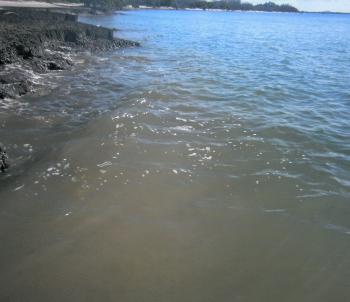
Even on bright clear days you can usually find discoloured water from boat chop.
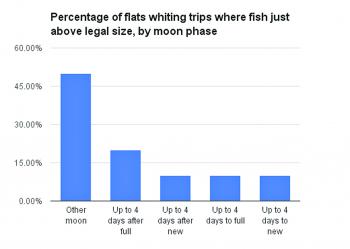
Percentage of flats whiting trips where the fish were just above legal size, by moon phase.
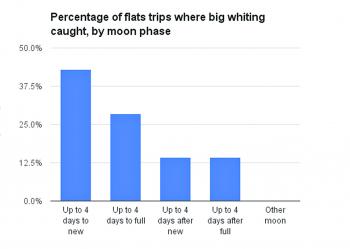
Percentage of flats trips where big whiting were caught, by moon phase.

Average number of flats whiting caught per person, with and without netters present.
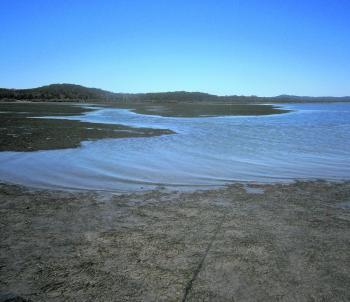
The falling tide is a perfect time to fish drains like this on the flats.
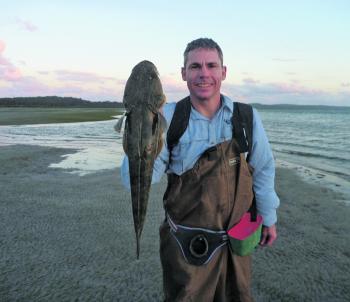
Pup with a nice flattie caught in front of the drains at low tide.
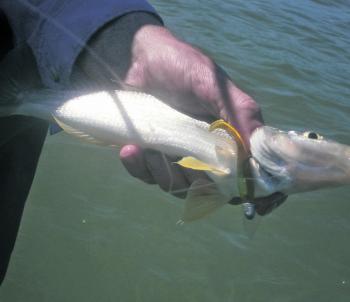
Whiting will take soft plastics on the shallow flats especially if the water isn’t too clear.

Double hook up in low light conditions.

The variety of fish caught on the flats improves with discoloured water and spring tides.
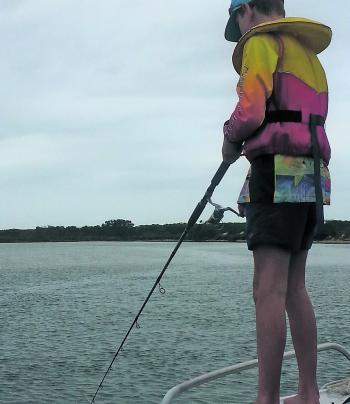
My son caught 10 flathead in 10 casts fishing this sandbank drop-off on the falling tide.
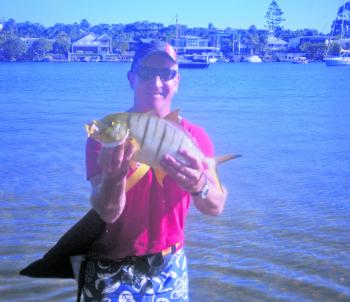
A juvenile golden trevally caught foraging for yabbies’ near high tide.
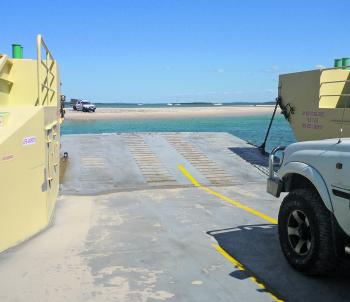
The beach at the Inskip Point car ferry is worth a fish just after the ferry departs.




